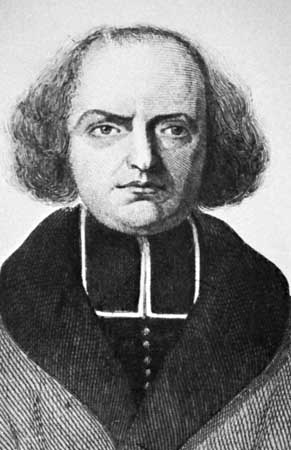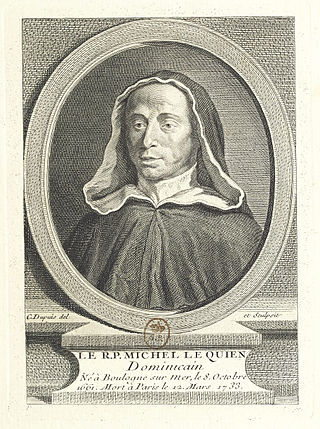
Jacques Paul Migne was a French priest who published inexpensive and widely distributed editions of theological works, encyclopedias, and the texts of the Church Fathers, with the goal of providing a universal library for the Catholic priesthood.

John IV, also known as John Nesteutes, was the 33rd bishop or Patriarch of Constantinople. He was the first to assume the title Ecumenical Patriarch. He is regarded as a saint by the Eastern Orthodox Church which holds a feast on September 2.
Cosmas of Maiuma, also called Cosmas Hagiopolites, Cosmas of Jerusalem, Cosmas the Melodist, or Cosmas the Poet, was a bishop and an important hymnographer in the East. He is venerated as a saint by the Eastern Orthodox Church and the Catholic Church.
The Patrologia Graeca is an edited collection of writings by the Christian Church Fathers and various secular writers, in the Greek language. It consists of 161 volumes produced in 1857–1866 by J.P. Migne's Imprimerie Catholique, Paris.

Jean-Baptiste-François Pitra, OSB was a French Catholic cardinal, archaeologist and theologian.

Saint Nilus the Elder of Sinai was one of the many disciples and stalwart defenders of St. John Chrysostom.
Hesychius of Jerusalem was a Christian priest and exegete, active during the first half of the fifth century. Nothing certain is known as to the dates of his birth and death (450s?), or, indeed concerning the events of his life. Bearing as he does the title πρεσβύτερος "priest", he is not to be confused with Bishop Hesychius of Jerusalem, a contemporary of Gregory the Great.

The Martyrology of Usuard is a work by Usuard, a monk of the Benedictine Abbey of Saint-Germain-des-Prés. The prologue is dedicated to Charles the Bald indicating that it was undertaken at that monarch's instigation. It was apparently written shortly before the author's death in 875.
Alexander of Lycopolis was a Christian writer who lived in Egypt in late third century and early fourth century. He was the writer of a short treatise, in twenty-six chapters, against the Manicheans. He says in the second chapter of this work that he derived his knowledge of Manes' teaching apo ton gnorimon.

George Hamartolos or Hamartolus was a monk at Constantinople under Michael III (842–867) and the author of a chronicle of some importance. Hamartolus is not his name but the epithet he gives to himself in the title of his work: "A compendious chronicle from various chroniclers and interpreters, gathered together and arranged by George, a sinner ". It is a common form among Byzantine monks. German 19th century scholar Karl Krumbacher protested against the use of this epithet as a name and proposed the form Georgios Monachos.
A patristic anthology, commonly called a florilegium, is a systematic collections of excerpts from the works of the Church Fathers and other ecclesiastical writers of the early period, compiled with a view to serve dogmatic or ethical purposes. These encyclopedic compilations are a characteristic product of the later Byzantine theological school, and form a very considerable branch of the extensive literature of the Greek Catenæ. They frequently embody the only remains of some patristic writings.
John Moschus, was a Byzantine monk and ascetical writer.

Caesarius of Nazianzus was a prominent physician and politician. He is best known as the younger brother of Gregory of Nazianzus. He is recognized as a saint in the Eastern Orthodox and the Catholic Church.
Eutychius of Alexandria was the Melkite Patriarch of Alexandria. He is known for being one of the first Christian Egyptian writers to use the Arabic language. His writings include the chronicle Nazm al-Jauhar, also known by its Latin title Eutychii Annales.
Orientius was a Christian Latin poet of the fifth century.

Michel Le Quien was a French historian and theologian.

Saint Simeon Stylites the Younger, also known as Simeon of the Admirable Mountain, is a saint in the Catholic Church and Eastern Orthodox Church.

Marcus Eremita, Mark the Ascetic or Marcus the Ascetic was a Christian theologian, saint, and ascetic writer of the fifth century AD.
Marcus Diadochus was a Christian writer of the fourth century.
Bartholomew of Edessa was a Syrian Christian apologist, and polemical writer. The place of his birth is not known; it was probably Edessa or some neighbouring town, for he was certainly a monk of that city, and in his refutation of Agarenus, he calls himself several times "the monk of Edessa". He is now dated to the thirteenth century.









